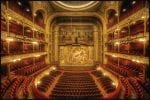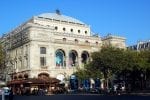In my current research about the Théâtre du Châtelet I in Paris I have encountered documentation on a number of concerts and premieres taking place there in the 1920s, however specificities of these concerts are lacking. I began my research process using the St. Olaf library system, to little success about the theater itself. However after digging through the performance log I found that many performances took place there throughout the 1920s. It is actually incredible the number of performances that took place there especially with all big name composers that we recognize today as some of the greats, many of whom got their first recognition performing on that stage.
- The interior stage and seating of the Théâtre du Châtelet. (image source: images: https://en.wikipedia.org/wiki/Théâtre_du_Châtelet)
- The Théâtre du Châtelet located on 2 rue Edouard Colonne in Paris, France. (image source: images: https://en.wikipedia.org/wiki/Théâtre_du_Châtelet)
As I continued my research, I found it most productive to research these individuals and their performances in the space. From the history tab on the theater’s website I learned when it opened in August of 1862, it could seat 2,500 people in the audience with a stage 24×35 meters, the largest venue of its type in Paris. It remained at this mark well into the early twentieth century. In 1873 the theater set up the Association des Concerts Colonne which was the Symphony Orchestra founded by Edouard Colonne and responsible for a number of performances and ballet collaborations at the theater. They played new works by Bizet, Staint-Saëns, Lalo, Massenet, and Ravel and brought back works of Mendelssohn, Wagner, Liszt, Schumann, Brahms and others to Paris. The theater played a pivotal in the music of Paris in the 20s as the a high class theater that had performances of many disciplines, theater, music, variety shows, operettas, cinema, and dance but became the principle music venue at the start of the 20th century.
The biggest struggle with this assignment so far is the research isn’t direct. It isn’t even as simple as going at it from the side door or back door. It is more like looking in every single door and grasping at the single strand of information each door presents you. For example, I found a book about European architectural design of theaters in the nineteenth through twentieth century that briefly mentioned the style of the Théâtre du Châtelet. Other resources will have a brief mention of a concert here and there so it’s really like looking for a needle in a haystack in terms of research. However, each other the little clues are informative and are helping me to build a net of connected ideas, performers, performances and music upon which to write my paper memo.


The non-directness of research is the bane of every scholar’s existence. But it’s also what makes what we do so exciting! You’re exploring new territory, mapping it as you go, speculating when you need to but always leaving behind a clearer sense of this new space than was left for you. Keep your head up – things are going better than you realize!